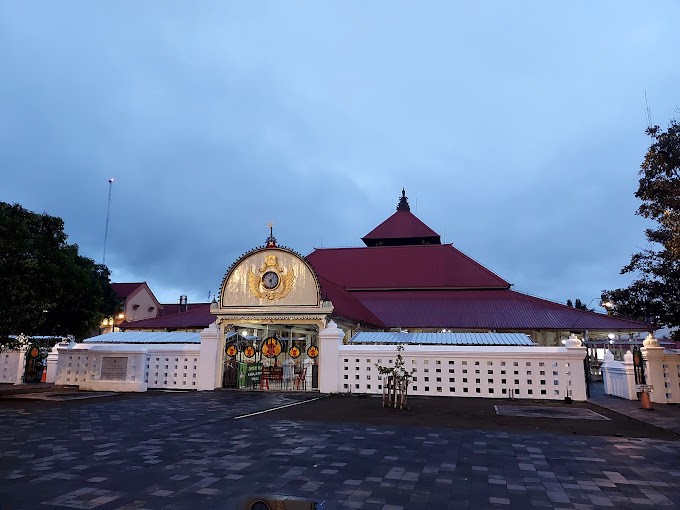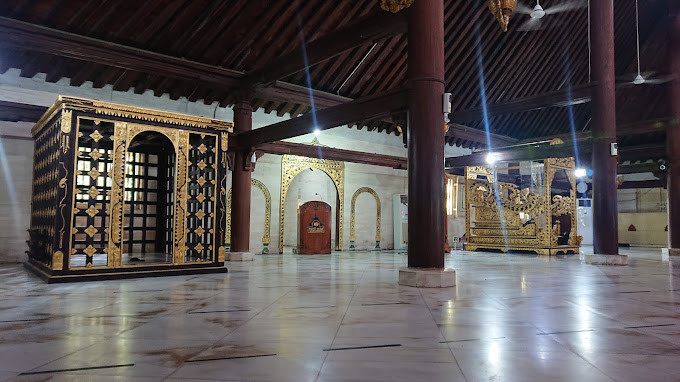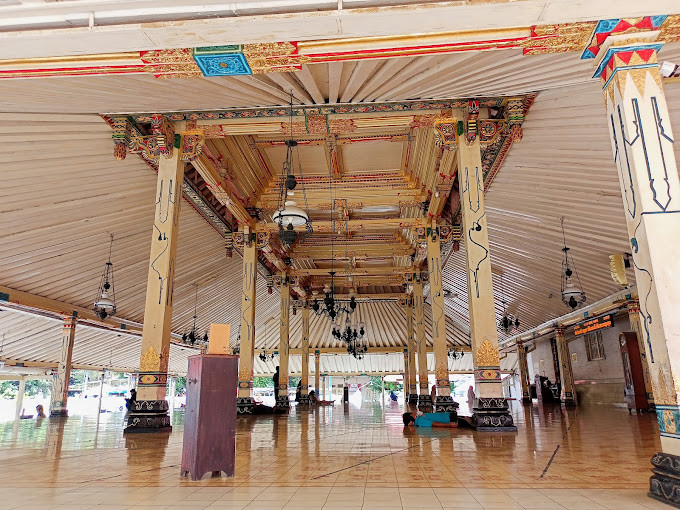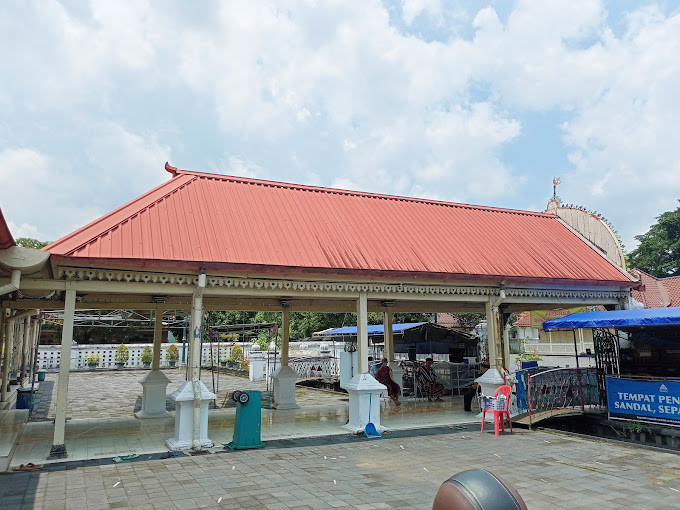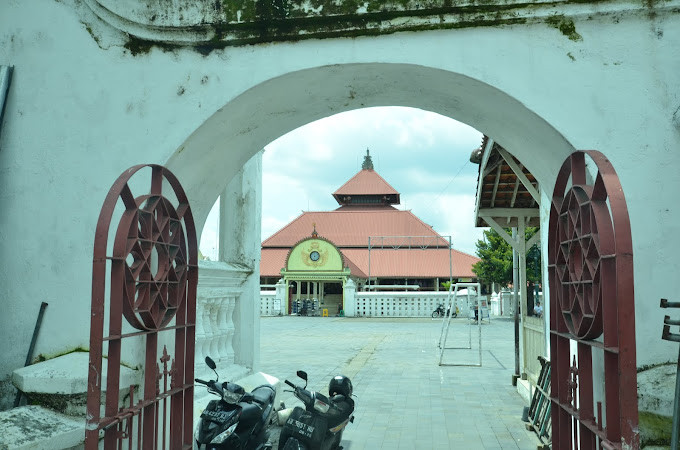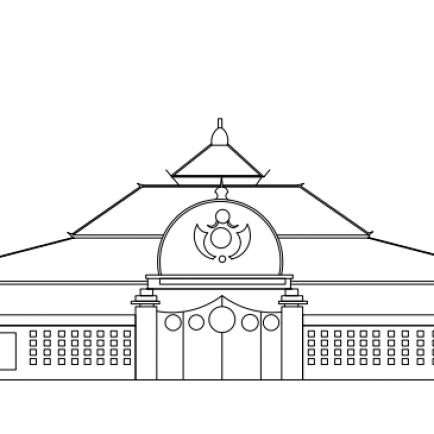Kauman Great Mosque
History
The mosque was established in the Kauman, an Islamic quarter near the kraton whose establishment is strongly related with the establishment of Yogyakarta in 1756 and the arrival of foreign Muslim leaders. Kauman Great Mosque was established by Hamengkubuwono I together with Kyai Faqih Ibrahim Diponingrat (the first headman of the Kraton) and Kyai Wiryokusumo as the architect. It was built on Ahad (Sunday) Wage, May 29, 1773 or 6 Rabi'ul Akhir 1187 in Islamic Calendar.
Urban and Architectural
The Gede Kauman Mosque is surrounded by high walls. The main gate of the complex is on the east side with a tinandu semar construction . The architecture of the main building is in the form of a closed square tajug with a three-sided roof equipped with mustaka as the top dome. To enter the main doors are on the east and north. On the western side there is a three-story pulpit made of wood, the mihrab (where the imam leads the prayers), and a cage-like building called maksura . In his day (for security reasons) in this place the sultan worshiped. The foyer of the mosque is in the form of an open rectangular pyramid .
The floor of the main room is made higher than the porch of the mosque and the floor of the porch itself is higher than the courtyard of the mosque. On the north-east-south side of the porch there is a small pond. In ancient times, this pond was used to wash the feet of people who wanted to enter the mosque.
In front of the mosque there is a yard planted with certain trees. In the north and south of the courtyard (northeast and southeast of the mosque building) there is a relatively tall building called Pagongan . The Pagongan in the northeast of the mosque is called Pagongan Ler (North Pagongan) and the one in the southeast is called Pagongan Kidul (South Pagongan). During the Sekaten ceremony , Pagongan Ler is used to house the sekati gamelan of Kangjeng Kyai (KK) Naga Wilaga and Pagongan Kidul for the sekati gamelan of KK Guntur Madu.
In the southwest of Pagongan Kidul there is a gate to enter the large mosque complex that is used in the Bata Trail ceremony at the Sekaten event series every Dal year. In addition, there is Pengulon, the official residence of kangjeng kyai pengulu on the north side of the mosque and the old cemetery on the west side of the mosque.
Description
Kauman Great Mosque is a Great Mosque of the Yogyakarta Sultanate in Java, Indonesia. It is located to the west of the North Alun-alun (public square) of Yogyakarta Kraton.
References
https://wisata.app/en-us/diary/kauman-great-mosque-in-yogyakarta
https://en.wikipedia.org/wiki/Kauman_Great_Mosque
Details
Location
Daerah Istimewa Yogyakarta
Worshippers
1000
Owners
Indonesian Mosque Council
Architect Name
Year of Build
1773
Area
1500
Drawings
Map
History
The mosque was established in the Kauman, an Islamic quarter near the kraton whose establishment is strongly related with the establishment of Yogyakarta in 1756 and the arrival of foreign Muslim leaders. Kauman Great Mosque was established by Hamengkubuwono I together with Kyai Faqih Ibrahim Diponingrat (the first headman of the Kraton) and Kyai Wiryokusumo as the architect. It was built on Ahad (Sunday) Wage, May 29, 1773 or 6 Rabi'ul Akhir 1187 in Islamic Calendar.
Urban and Architectural
The Gede Kauman Mosque is surrounded by high walls. The main gate of the complex is on the east side with a tinandu semar construction . The architecture of the main building is in the form of a closed square tajug with a three-sided roof equipped with mustaka as the top dome. To enter the main doors are on the east and north. On the western side there is a three-story pulpit made of wood, the mihrab (where the imam leads the prayers), and a cage-like building called maksura . In his day (for security reasons) in this place the sultan worshiped. The foyer of the mosque is in the form of an open rectangular pyramid .
The floor of the main room is made higher than the porch of the mosque and the floor of the porch itself is higher than the courtyard of the mosque. On the north-east-south side of the porch there is a small pond. In ancient times, this pond was used to wash the feet of people who wanted to enter the mosque.
In front of the mosque there is a yard planted with certain trees. In the north and south of the courtyard (northeast and southeast of the mosque building) there is a relatively tall building called Pagongan . The Pagongan in the northeast of the mosque is called Pagongan Ler (North Pagongan) and the one in the southeast is called Pagongan Kidul (South Pagongan). During the Sekaten ceremony , Pagongan Ler is used to house the sekati gamelan of Kangjeng Kyai (KK) Naga Wilaga and Pagongan Kidul for the sekati gamelan of KK Guntur Madu.
In the southwest of Pagongan Kidul there is a gate to enter the large mosque complex that is used in the Bata Trail ceremony at the Sekaten event series every Dal year. In addition, there is Pengulon, the official residence of kangjeng kyai pengulu on the north side of the mosque and the old cemetery on the west side of the mosque.
Description
Kauman Great Mosque is a Great Mosque of the Yogyakarta Sultanate in Java, Indonesia. It is located to the west of the North Alun-alun (public square) of Yogyakarta Kraton.


